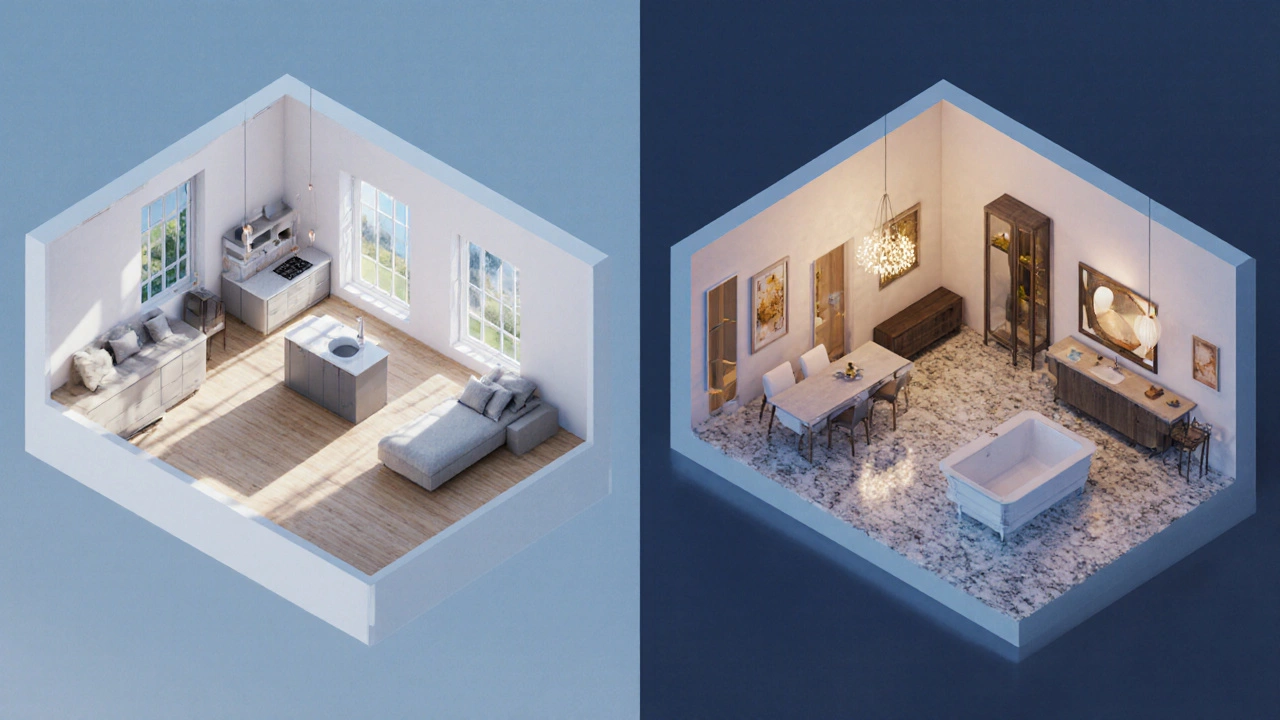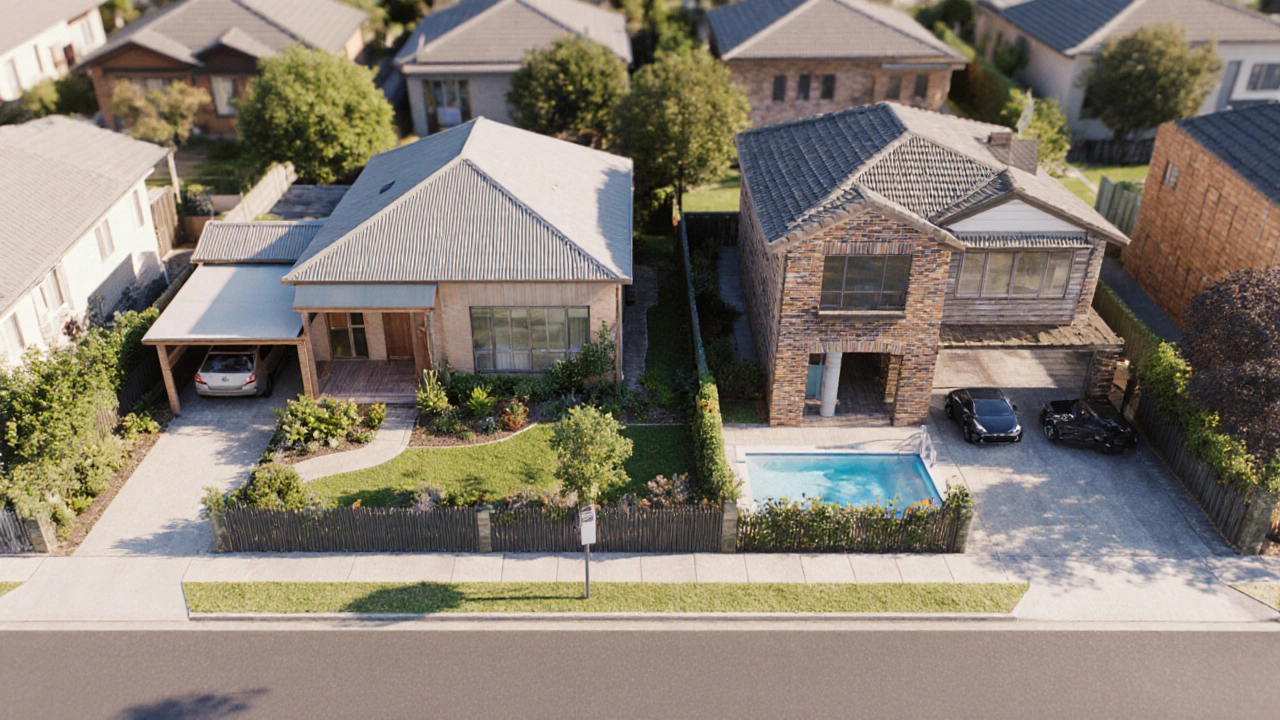Cottage vs Villa Size Comparison Tool
Cottage
Typical characteristics
- Interior Floor Area 80–150 m²
- Land Parcel Size 200–600 m²
- Bedrooms 2–3
- Bathrooms 1–2
Villa
Typical characteristics
- Interior Floor Area 180–350+ m²
- Land Parcel Size 500–2,000+ m²
- Bedrooms 3–5
- Bathrooms 2–4
Size Visualization
Compare average sizes visually:
Interactive Size Calculator
Enter your preferred dimensions to see how they compare:
Enter your preferred sizes and click "Compare My Sizes" to see the comparison results.
When it comes to cottage vs villa size, most people picture a tiny, cozy cabin on one side and a sprawling, luxury estate on the other. The reality is a bit messier - size varies by region, design, and market segment. This guide breaks down the numbers, amenities, and typical layouts so you can tell which property type generally offers more space.
What Exactly Is a Cottage?
Cottage is a small, often single‑storey residential dwelling that originated as a rural holiday home but today includes modern suburban versions. In Australia, cottages usually range from 80m² to 150m² of internal floor area, sit on plots between 200m² and 600m², and feature 2‑3 bedrooms.
What Exactly Is a Villa?
Villa is a larger, upscale detached house that often includes multiple storeys, private gardens, and premium finishes. Villas in the Melbourne market typically start at 180m² of internal space, can exceed 350m², and sit on land parcels from 500m² to over 2,000m².
Typical Size Metrics
Two key measurements dominate any size comparison: square footage (or square metres) and land area. Below is a snapshot of average figures drawn from recent property listings (2024‑2025 data):
- Average cottage interior: 110m² (≈1,184sqft)
- Average cottage land: 400m² (≈4,305sqft)
- Average villa interior: 250m² (≈2,690sqft)
- Average villa land: 1,100m² (≈11,840sqft)

Bedrooms, Bathrooms, and Layout
Space isn’t just about total area; how that area is divided matters. A typical cottage offers 2‑3 bedrooms and 1‑2 bathrooms, often with an open‑plan living/kitchen area. A villa, by contrast, frequently provides 3‑5 bedrooms, 2‑4 bathrooms, plus separate living, dining, and sometimes a home office or gym.
Price Ranges and Market Position
Price correlates with size, location, and finish quality. In the greater Melbourne region (as of Q32025):
- Cottages sell for roughly AUD350,000-AUD650,000.
- Villas command AUD950,000-AUD2.5million, with premium waterfront or hill‑top sites breaking the AUD3million mark.
These figures illustrate that villas not only tend to be bigger but also target a higher‑income buyer segment.
Lifestyle, Amenities, and Construction Style
Beyond raw numbers, the lived‑in experience differs. Cottages often have simpler construction - timber frames, modest roofing, and limited landscaping. Villas may feature brick or stone exteriors, multiple roofing tiers, private pools, carports for two‑plus cars, and landscaped gardens with irrigation.
Side‑by‑Side Comparison Table
| Feature | Cottage | Villa |
|---|---|---|
| Internal floor area | 80-150m² | 180-350+m² |
| Land parcel size | 200-600m² | 500-2,000+m² |
| Bedrooms | 2‑3 | 3‑5 |
| Bathrooms | 1‑2 | 2‑4 |
| Typical price (Melbourne) | AUD350k‑650k | AUD950k‑2.5M |
| Key amenity | Cozy garden, low maintenance | Pool, multiple car spaces, premium finishes |

Which Is Bigger? The Bottom Line
Based purely on average measurements, a villa outstrips a cottage in every dimension - interior space, land size, bedroom count, and typical price tier. That said, the term “bigger” can be subjective. If you value a larger plot for gardening but don’t need a massive house, a high‑end cottage on a big lot can feel bigger than a compact villa in a dense suburb.
How to Choose the Right Size for Your Needs
- Identify your core priorities. Do you need extra bedrooms for a growing family, or is a spacious backyard more important?
- Set a realistic budget. Remember that larger land brings higher council rates and maintenance costs.
- Consider future resale. Villas tend to retain higher resale values in upscale neighbourhoods, while cottages are in demand among first‑time buyers.
- Visit multiple properties. Square footage on paper can be deceptive; walking the floor plan tells you how usable the space truly is.
- Check local zoning. Some council areas restrict extensions on cottages but allow multi‑storey builds for villas.
Common Misconceptions
Myth 1: All cottages are tiny. Reality: Luxury cottages, especially in coastal regions, can exceed 200m².
Myth 2: Villas always have pools. Reality: Not every villa includes a pool; many urban villas forego it to save space.
Myth 3: Bigger always means better. Reality: Maintenance, heating, and property taxes rise with size. A well‑designed cottage may offer a higher quality‑of‑life per square metre.
Frequently Asked Questions
Is a cottage ever larger than a villa?
In rare cases, a luxury cottage built on a large estate can have a bigger footprint than a compact, urban villa. However, on average, villas consistently surpass cottages in total floor area and land size.
Do I pay more council rates for a villa?
Council rates are calculated on land value and size. Because villas usually sit on larger parcels, their rates are higher. Some municipalities also levy additional fees for amenities like private pools.
Can I convert a cottage into a villa?
Conversion is possible but depends on zoning, structural capacity, and budget. Adding a second storey or expanding the footprint often requires council approval and significant investment.
Which property type offers better resale value?
Villas in premium suburbs generally appreciate faster and command higher resale prices. Cottages in high‑growth outer‑urban areas can also perform well, especially if land sizes are sizable.
How does maintenance differ between the two?
Villas typically require more upkeep - larger roofs, multiple external walls, and possible pool maintenance. Cottages often have simpler structures, leading to lower annual maintenance costs.






